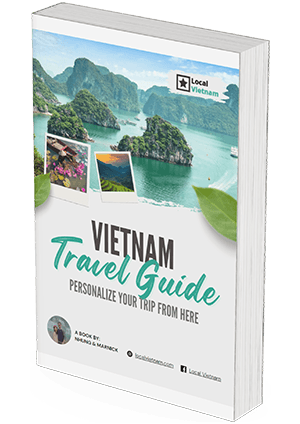Best time to visit the beaches of Vung Tau
Before diving into the list of best beaches in Vung Tau, it’s worth knowing that timing makes a big difference to your experience. The city has two distinct seasons:
- Dry season (November–April): This is the best period for beach trips, with more sunshine, calmer seas, and clearer skies. Swimming is usually safe and more pleasant.
- Rainy season (May–October): Expect heavy showers, often in the afternoon, along with stronger winds and bigger waves. During this time, rubbish from rivers can wash onto the shore, which makes the beaches less appealing.
- Transition months (April and October): Conditions can be mixed. You might get a few sunny days in a row, but also unstable weather and rough seas.
If you’re planning a trip mainly to swim and relax on the sand, the worst months are mid-July to September, when storms, high waves, and beach pollution are most common.
Avoiding crowded holidays
Even in the dry season, not all days are equal. Tet (Lunar New Year, usually a week either at the end of January or the beginning of February) and the April 30 – May 1 Reunification holidays are notorious for crowds. Vung Tau is the nearest beach to Ho Chi Minh City, so tens of thousands of people head here at the same time. Hotels get booked out, traffic is heavy, and beaches are packed with families. Unless you enjoy big crowds, these dates are best avoided.
Layout of the beaches in Vung Tau
The main city beaches
Vung Tau has two central beaches that shape the city. Front Beach (Bai Truoc) lies on the western side of the peninsula. It’s more of a promenade and sunset spot, with boats anchored in the bay, rather than a true swimming beach. On the eastern side, Back Beach (Bai Sau) stretches for several kilometers and is the city’s main bathing area, lined with hotels, seafood restaurants, and beach clubs.
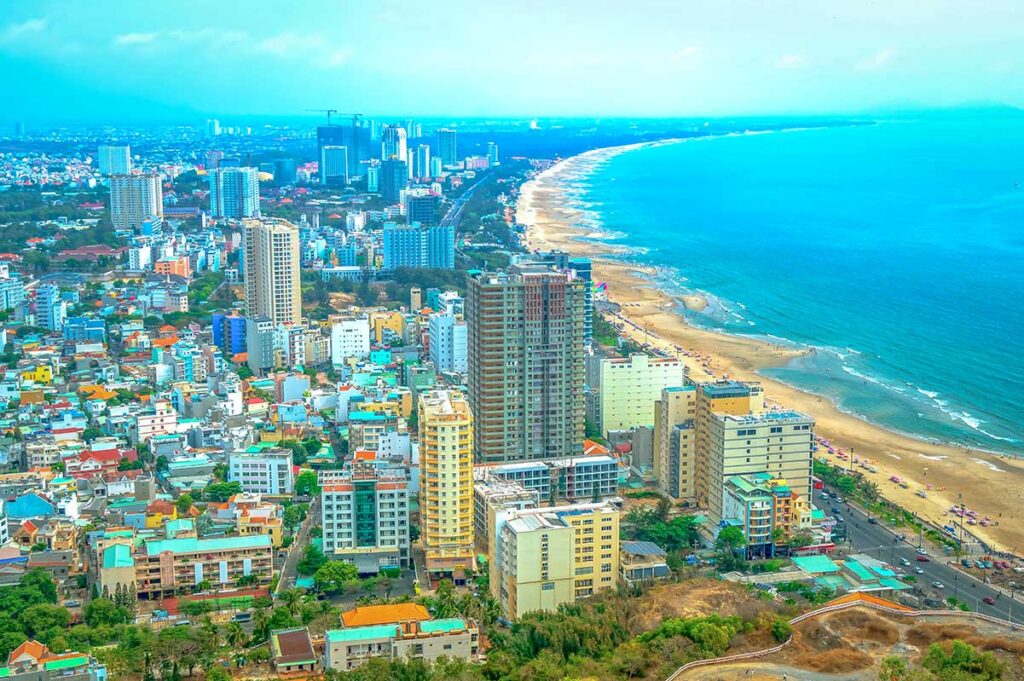
Smaller in-town beaches
Between these two main areas, a few smaller beaches are tucked into the coastline. Pineapple Beach (Bai Dua) sits at the foot of the Jesus Christ statue and is popular for sunsets, though it almost disappears at high tide. Vong Nguyet Beach (Moon Beach) at Nghinh Phong Cape is harder to reach but scenic and photogenic. Further north, Dau Beach (Bai Dau) offers sea views framed by temples and hillsides, though the water is not always clean for swimming.
Beaches north of the city
Traveling north along the coastal road brings you to quieter and often cleaner stretches. Ho Tram and Ho Coc are the best-known, with resorts maintaining their own beachfronts. Loc An, Suoi O, and Phuoc Hai are more rustic, with sandy shores, fishing villages, and less infrastructure — better if you’re looking for a natural atmosphere rather than full facilities.
Public vs. resort beaches
It’s important to distinguish between public beaches, which are lively but often crowded and sometimes polluted, and resort/private beaches, which are cleaned daily and generally more pleasant, though they require staying at a resort or paying a fee for access..
9 Best Beaches in Vung Tau (and around)
When looking for the best beaches in Vung Tau, it’s easy to get overwhelmed by long lists that make every spot sound perfect. This guide is different: the list starts with the two most famous beaches in town — Back Beach and Front Beach — because they are central to the city’s identity, not because they are necessarily the most beautiful in Vietnam. After those, we look at some of the cleaner and quieter options outside the city, which often provide a better overall beach experience.
1. Back Beach (Bai Sau)
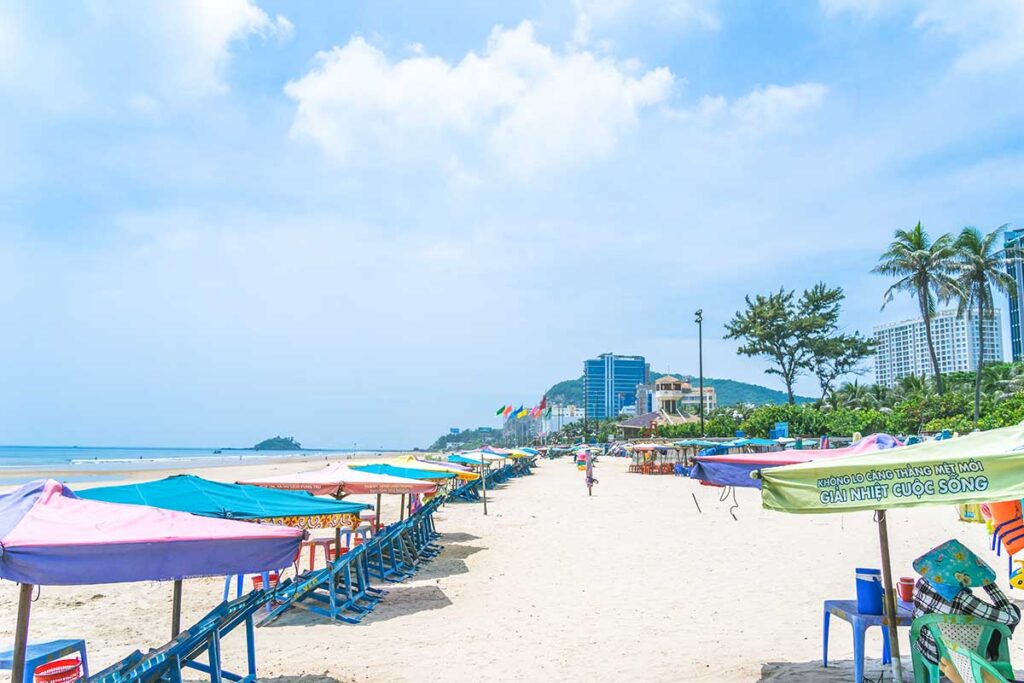
Back Beach is the main stretch of sand in Vung Tau, running for several kilometers along Thuy Van Street. Recently renovated with a huge investment, the area now has new parks, walkways, and facilities like foot-washing stations and service kiosks. On weekdays, it can feel wide and relaxed, but weekends see waves of families from Ho Chi Minh City, making it crowded and noisy.

The water is generally fine for swimming, though currents can be strong. Deck chairs, umbrellas, and water sports like jet skis and parasailing are easy to find. This beach works well if you want a lively atmosphere and convenience right in the city, but don’t expect pristine water or tranquility.
2. Front Beach (Bai Truoc)
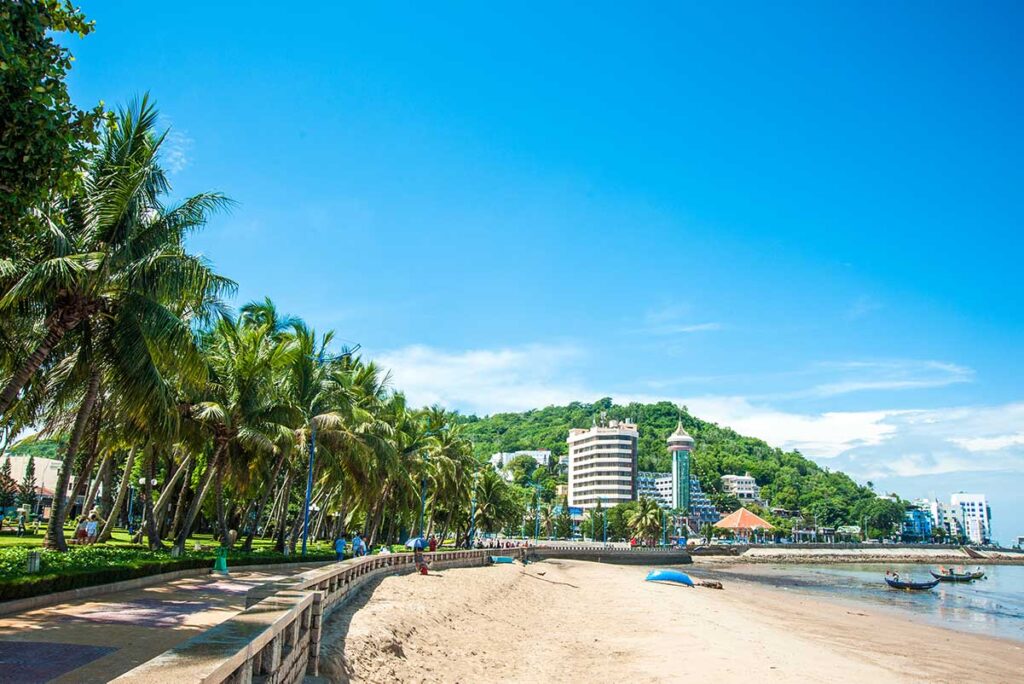
Front Beach sits on the western side of the peninsula and is more of a city park and promenade than a true swimming beach. Fishing boats are anchored in the bay, and the area has a nice atmosphere for evening walks, sunsets, and people-watching. The water here is not clean enough for swimming, but the promenade is lined with cafes, seafood restaurants, and benches under shady trees. It’s worth a visit if you’re staying in Vung Tau, but it’s not where you go for a beach day.
3. Ho Tram Beach

Located about 30 km north of Vung Tau city, Ho Tram is often described as one of southern Vietnam’s nicest beaches. The sand is wide and pale, the water relatively clean, and the beach is long enough to find a quiet spot away from others. Resorts and seafood shacks line certain parts, and while it’s busier on weekends, it’s still calmer than Back Beach. It’s a good choice if you want to combine a beach trip with an overnight stay at a resort, or if you’re looking for a more natural alternative within easy reach of Ho Chi Minh City.
4. Ho Coc Beach

Just a little further north from Ho Tram, Ho Coc is another popular option, known for its mix of sandy stretches and rocky outcrops. The beach feels more scenic, with waves breaking against large boulders and pine trees lining the shore. Several resorts keep their beachfronts clean and offer facilities like sunbeds, pools, and restaurants. Public areas can be less tidy, but overall it’s one of the more attractive coastal spots in the region. Ho Coc is especially good for travelers who want a quiet overnight stay with a touch of scenery and don’t mind being a bit further from Vung Tau city.
5. Loc An Beach

Loc An is a quiet beach about 50 km north of Vung Tau. The sand is soft and clean, the water usually calm, and crowds are rare outside weekends. There are no major resorts here, so you won’t find many facilities beyond a few local shops. That makes it a great stop for a coastal motorbike ride or for travelers looking for a more natural, laid-back atmosphere. If you want deck chairs, restaurants, or nightlife, this is not the place.
6. Suoi O Beach
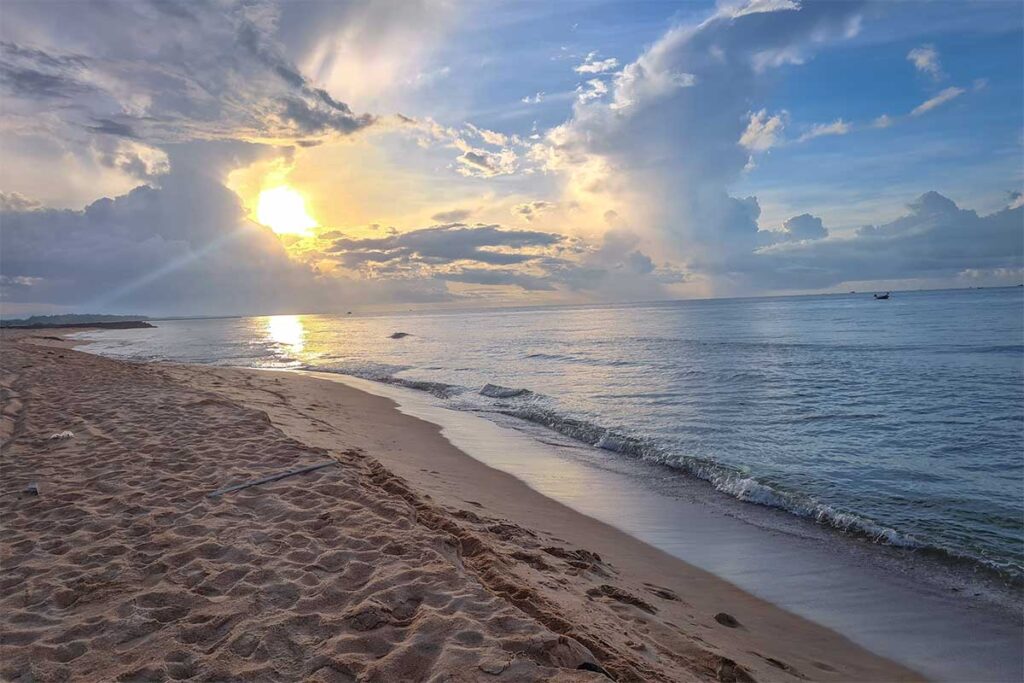
Suoi O is a bit of a hidden spot near Binh Chau, where a small river flows into the sea. It’s known for the unusual sight of freshwater and saltwater running parallel before meeting. The setting is beautiful and still feels raw, but reviews are mixed: some call it breathtaking, while others note trash washing in from the fishing port nearby. Facilities are very limited, so it works better as a short stop for those who enjoy exploring less-developed beaches rather than a full day of swimming.
7. Vong Nguyet (Moon Beach)
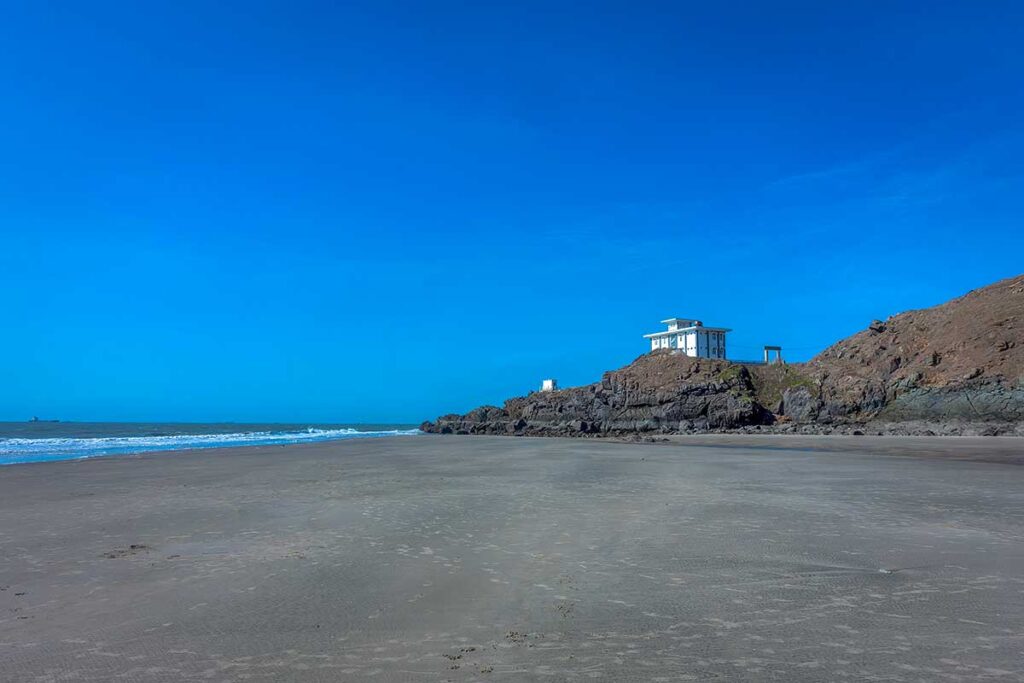
Vong Nguyet lies just below Nghinh Phong Cape and can only be reached by a rocky path. The beach is small, with clear water and good views of the Christ the King statue. It’s quiet compared to Back Beach, but access is tricky and waves can be rough. Locals like it for its atmosphere and photo opportunities, though it’s not ideal for families or those looking for easy facilities.
8. Pineapple Beach (Bai Dua)
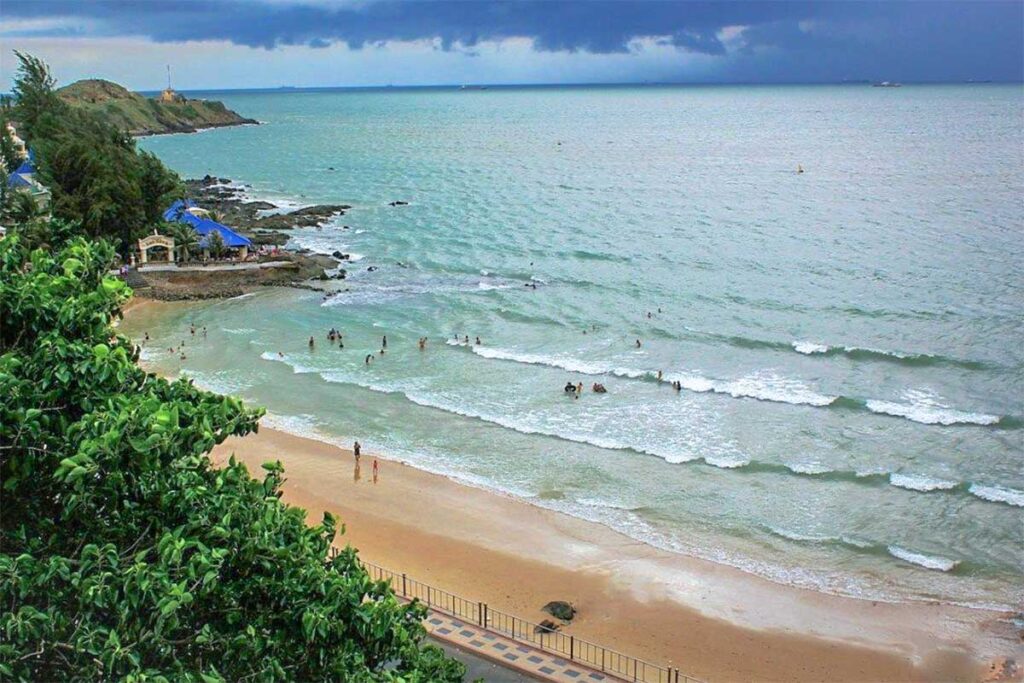
Pineapple Beach is one of the smallest beaches in town, tucked under Ha Long Street near the Jesus statue. At high tide, there’s barely any sand, but at low tide it’s a pleasant swimming spot. Reviews from locals often highlight its cleaner water compared to other city beaches, though in rainy season rubbish from rivers can still wash up. It’s a good choice for sunset views and a quick dip, but don’t expect a wide sandy bay.
9. Phuoc Hai
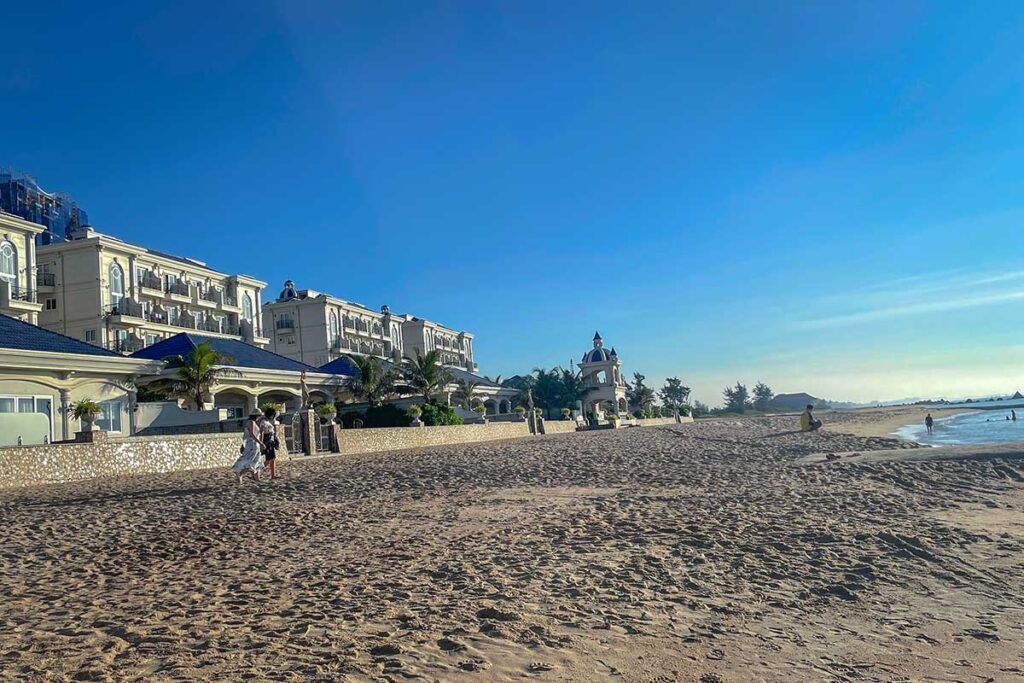
Phuoc Hai is a fishing village with a public beach about 24 km north of Vung Tau. The setting is lively, with seafood restaurants, markets, and locals heading out to fish. The sand and water are decent, though not as scenic as Ho Tram or Ho Coc. The main appeal here is the combination of beach time with authentic local culture and cheap, fresh seafood. For travelers wanting both a swim and a glimpse of everyday coastal life, Phuoc Hai is a rewarding stop.
Tips for visiting beaches of Vung Tau
Getting around
For in-town beaches like Back Beach, Front Beach, Pineapple, or Vong Nguyet, you can easily walk or use Grab to get around. To reach out-of-town beaches such as Ho Tram, Ho Coc, Loc An, Suoi O, or Phuoc Hai, the best options are motorbike rental, a private car with driver, or a local taxi. Public transport isn’t convenient for these stretches.
What to bring
Carry cash, as most vendors selling drinks, snacks, and sunbeds don’t accept cards. Bring sun protection — hat, sunglasses, and sunscreen are essential under the strong southern sun. A swimsuit, towel, and flip flops are enough for most beaches, though a change of clothes is handy if you’re planning to visit restaurants afterward.
Dealing with trash and pollution
Vung Tau’s beaches are not always pristine. After heavy rain or busy weekends, expect to see plastic washed ashore. For a cleaner experience, go on weekdays or choose resort beaches where staff maintain the sand daily. Back Beach is cleaned regularly by the city, but smaller local beaches like Pineapple or Dau depend more on occasional clean-ups and can be hit-or-miss.
Best times of day
Mornings are the most peaceful time to enjoy the beach, with cooler air and fewer people. Late afternoons are also pleasant, with softer light and a chance to pair swimming with a seafood dinner. Midday is the least comfortable time — the sun is harsh, shade is limited, and beaches feel hotter than in the early or late hours.
Are the beaches of Vung Tau worth visiting?
Vung Tau is first and foremost a convenient escape from Ho Chi Minh City. It’s close enough for a day trip or weekend break, which is why it’s packed with domestic tourists and a community of expats who live here long-term.
For foreign travelers, however, the beaches are not among the most beautiful in Vietnam. The sand and water are fine in parts, especially since Back Beach has been renovated, but cleanliness issues remain and the atmosphere can feel more functional than idyllic.
If you have more time, most people agree you’ll find better beach destinations in Mui Ne, Phu Quoc, Con Dao, or along the central coast in places like Nha Trang, Da Nang, or Phu Yen.
That said, Vung Tau is still worth it if you want a quick and easy beach trip near Saigon — a place to swim, eat fresh seafood, and combine with a few cultural sights without traveling too far.

